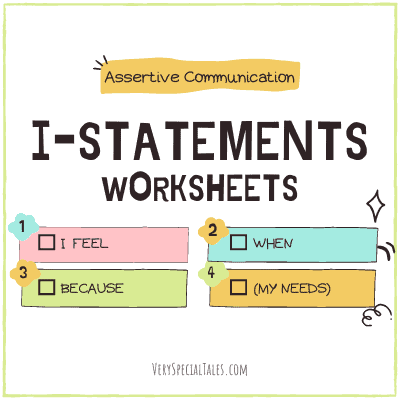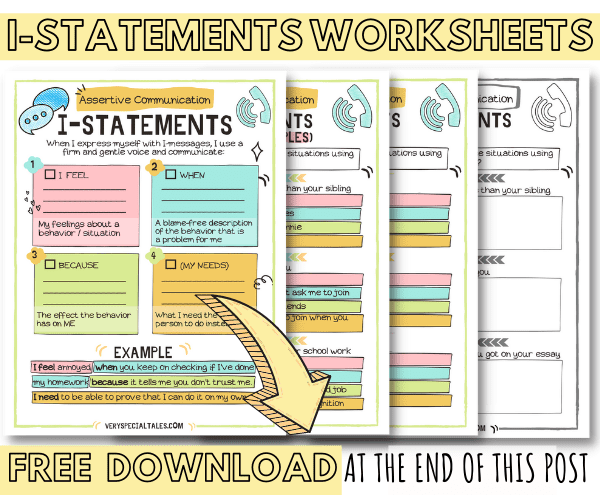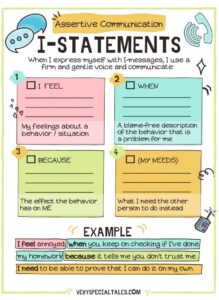
I-Statements: Examples & Fun Worksheets (Free PDF Download)
I-Statements / I-Messages: In this post, we will explore why it makes sense to move from you-statements to I-statements to deal with conflict resolution at home (or school) and improve family communication. We will share I-statement examples and you will be able to download your free “I-Statements PDF” at the end of the post.
Do you feel your kid gets defensive each time you give them feedback on a behavior?
Does every interaction end up in an argument?
Does your child (or your partner) always seem to take your words as criticism?
Taking a closer look at your own communication style and how you phrase your views and needs may be an eye-opening experience.
In our case, I can definitely state that making a conscious effort to use I-messages in our family communication has proven to be a successful strategy.
- Related Reading: Assertive Communication for Kids
Table of Contents
- What is an I-Message or I-Statement?
- I-Statements vs You-Statements
- Parts of an I-Statement and I-Statement Examples (Two, three and four-part I-statements)
- You-Messages Disguised as I-Statements
- When Do We Use I-Statements
- How to Communicate Anger with I-Statements (and not sounding like “You made me angry!”)
- I-Statement Worksheets (free PDF Download)
What is an I-message or I-statement?
An I-message is an affirmation about our own feelings and circumstances that seeks to avoid judgment, guilt, or blame on the receiving person’s side.
When we use I-messages in assertive communication, our ultimate goal is to achieve a behavior change in the other person.
By focusing on the effects on ourselves, this type of communication is more likely to elicit a positive response, as the other party is less likely to feel defensive and more likely to make the change we need.
Examples are far more illuminating than definitions, so let’s look at these two sentences:
- You need to help more with the kitchen clean-up
- I feel tired and need help with the kitchen clean-up so I can sit down and relax earlier.
The second sentence is an “I-statement”. It doesn’t imply the other person is not doing enough, and it doesn’t come across as an order.
The term “I statement” or “ I message” was coined by Dr. Thomas Gordon.
Dr. Gordon was a reputable clinical psychologist, recognized for his communication and conflict resolution training programs for parents, teachers, and organizations.
Dr. Gordon first reflected on the concept while doing play therapy with kids in the 60s. He realized that asking a child to stop or change a behavior could convey criticism, fault, or blame.
But, if that same message was rephrased as an I-message focusing on the effect that the behavior was having on him, it would turn into a more effective and blame-free interaction.
I-Statements vs. You-Statements
So, what is the problem with you-messages in interpersonal communication?
Whether intentionally or not, when we use you-messages to request somebody’s behavior change we may be conveying some underlying nuances:
- Judgment
- Blame
- Guilt
- Direction-giving
What is the effect of this type of communication on the other person?
They may get defensive, blame back, or deny being at fault.
There is plenty of research that suggests that I-statements are more likely to elicit a positive response when we are dealing with conflict in interpersonal communication:
- Assertive “I” messages are less likely to evoke animosity and antagonistic behavior than accusatory “you” messages
- “I”/distress statements evoked the weakest antagonistic tendencies and the strongest solicitous tendencies. (Psycnet)
These research findings have been replicated in different age groups (including adolescents), different cultures and are similar for both males and females.
Examples of the Effect of You-Messages on our Communication
- (You-Statement) You didn’t clean up the table
(Blame back response) Mike didn’t do it either - (You-Statement) You are talking too loud
(Defensive/Not being at fault) This is the way I talk, everything bothers you
Parts of an I-Statement
You may have found I-statements presented in different ways:
- Two-part I-Statements
- Three-part I-Statements
- Four-part I-Statements (our I-message worksheets at the end of this post follow this last formula)

Two-part I-Statements
This is the simplest approach.
A two-part I-message will state:
- Your feelings
- The problem behavior
And the following formula is a helpful way to construct our statement:
- “I feel” ⇒ your emotional experience
- “When” ⇒ blame-free description of the problem behavior
I will share three examples (from a kid’s perspective), one for each type of I-message, using the same scenario.
Example Two-Part I-Statement
Scenario: Your Mom keeps coming to check if you have gone through all the steps in your bedtime routine (eg. milk-pyjamas-teeth-toilet)
- I feel frustrated when you keep checking for each step of my routine. (Sounds better than “just leave me alone!”, doesn’t it)
Three-part I-Statements
Dr. Gordon defined the three parts of an I “statement” as:
- A non-blameful description of the BEHAVIOR you find unacceptable.
- Your FEELINGS.
- The tangible and concrete EFFECT of the behavior on you
It adds to the previous formula, communicating how that behavior is affecting us.
Let’s look at all these three parts, and how important they are:
- Objective Behavior Description.
The behavior description needs to be objective, non-judgmental and blame-free. You seek to ensure you don’t get the undesired antagonistic reaction to your problem.
- Feelings.
Sharing your emotional experience shows that you are vulnerable and may make the person listening empathize with your problem or situation. - Tangible effect.
Stating a tangible effect may result in a double benefit:- making the other side understand your situation -> they may not even be aware of the effect that behavior is having on you
- it forces us to really understand if that behavior was really an issue -> sometimes you may realize there was not a real objective effect but your own feelings about it.
Dr. Gordon reckoned that if any of these parts are missing in our message, the I-statement is incomplete and less likely to work.
If we expand the formula in our two-part statement, our three-part statement would look as follows:
- “I feel” ⇒ your emotional experience
- “When” ⇒ blame-free description of the problem behavior
- “Because” ⇒ how it affects you
Example of Three-Part I-Statement
Let’s go back at our previous example, and how it would look now:
- I feel frustrated when you keep checking for each step of my routine, because it tells me you don’t trust me
Four-part I-Statements
This last formula adds something important: what we need the other person to do instead.
At the end of this post, you will be able to download our I-Statements worksheets using this type of formula.
You may or may not use this last part of the formula, depending on how directive you want to be with the behavior change you expect from the other person.
The statement would look as follows:
- “I feel” ⇒ your emotional experience
- “When” ⇒ blame-free description of the problem behavior
- “Because” ⇒ how it affects you
- “My needs” ⇒ let them know what you need them to do instead.
Example of Four-Part I-Statement
Going back to our example, this is how a four-part I-message could read:
- I feel annoyed when you keep on checking if I’ve done my homework because it tells me you don’t trust me. I need to be able to prove to you that I can do it on my own.
You-Messages Disguised as I-Messages
Sometimes, we may feel we are addressing others with I-messages, and surprised not to see its magic come into effect.
The fact is, that we often use I-messages that are you-messages in disguise.
Let’s look at some examples:
- I think …
You may think that you are using an I-statement here.
But you are actually expressing an opinion. Not every sentence that starts with “I” ticks all the boxes to be considered an I-message - I feel THAT
Check out the change in nuances here:
I feel + adjective expresses how we are feeling (I feel sad, I feel sorry…)
But
I feel THAT expresses an opinion - I feel angry…
“I feel angry” will almost invariably be decoded as a “You are making me angry” message.
If you tell your kid “I feel angry because you arrived home late”, you are expressing the same idea as if you said “You made me mad because you arrived late”
When do we Use I-Messages?
I-statements are often found in the following situations or context:
- Assertive communication – expressing our needs and desires while we respect others’ perspectives
Related: Assertive Communication for Kids - Conflict resolution
I-statements facilitate reaching a solution that is satisfactory for both sides. Blame-free non judgmental communication is more likely to elicit a positive response and reach win-win resolutions. - Constructive criticism
It allows us to express our views about an issue without direct criticism
“I was not clear on the main idea you wanted to communicate”
vs “You didn’t write a good essay”
How to Communicate Anger with I-Statements
One of our readers left a very valuable comment that I think many other readers could benefit from.
How can we express the feeling of anger safely and assertively in I feel statements?
Because it seems that “I feel angry when you…” does not make a good fit, as outlined above. “I feel angry” will almost invariably be decoded as a “You are making me angry” message.
My question is – how can we communicate anger instead?”
I think this is a great question because when someone hears us say, “I feel angry…” and we are expressing what the other person did, it is almost impossible not to interpret it as “You made me angry.” And it is indeed one of our examples of you-message disguised as an I-message.
A good way to work around this is to explore the deeper layers of our anger.
As I explained in my Anger Iceberg article, anger is easy to spot. But this powerful emotion may be hiding other underlying feelings and emotions.
Therefore, a way to communicate that feeling more effectively (and assertively!) is to dig deeper into those other emotions, so instead of saying, “I feel angry when…”, I may say:
- I feel frustrated
- I feel ashamed
- I feel embarrassed
- I feel jealous
Examples of Anger I-Statements (that don’t translate as “You Make Me Angry”)
Examples of anger I-statements that would avoid using words like anger, mad, or furious could be:
- I feel ignored when you don’t listen to me about my hobbies because it seems like you don’t care about what’s important to me. I need to feel that my interests are respected.
- I feel annoyed when you check my phone without asking because it feels like you don’t trust me. I need some privacy to feel trusted and independent.
- I feel left out when I’m not invited to hang out because it makes me feel unwanted. I need to feel included by my friends to know our friendship is valued.
- I feel pressured when there’s a huge emphasis on grades because it makes me anxious about my future. I need support and encouragement to do my best without the stress.
- I feel embarrassed when my mistakes are pointed out in a group setting because it puts me on the spot. I need feedback to be given privately to help me learn without feeling shamed.
- I feel overwhelmed when you ask me to do too many chores during exam week because it’s hard to manage everything. I need some understanding and flexibility with my responsibilities during stressful times.
Other Social Skills Resources
If you found this article interesting, the following posts also have related content:
- Assertive Communication Worksheets for Kids
- Social Skills Activities for Kids
- Social Skills Games
- Social Skills Checklist
- Fun Conflict Resolution Activities for Kids
I-Statement Worksheets Download
Would you like to practice I-statements at home with your kids?
Check out these I-Messages Worksheetss for Kids (you may find them useful too!)

10 Comments
Gina
Everyone can benefit from assertive communication skills!
Megan
Love your post, so informative! I grew up with this system but didn’t know the research behind it. Fantastic to implement in my classroom!
Clara
Thanks, Megan.
Samantha
I can’t find the free downloads. Maybe they aren’t loading.
Clara
Hi Samantha,
You can find the download forms at the end of the posts. If you can’t find them you may try reloading the page.
I hope you find these resources helpful.
Clara
Rebecca
This is wonderful, just waiting to receive an email to verify my subscription in order to download worksheets.
Verónica
Excellent material, thanks for sharing
Iz
I am confused about how to express anger, which is a valid feeling and deserves to be heard, in a non-confrontational / blaming way.
How can we express the feeling anger safely + assertively into I feel statements?
Because it seems that “I feel angry when you” does not make a good fit, as outlined above: “I feel angry… “I feel angry” will almost invariably be decoded as a “You are making me angry” message.”
My question – how can we communicate anger instead?
Clara
Hi Iz, thanks for your comments. This is actually a great question. So, I’ve decided to add it as a section at the end of the post. I’ve suggested ways to express anger using I-statements and added a few examples to illustrate how it could look.
Thanks for helping me improve this post!
Clara
Karen
Thank you for resharing this blog about I statements. I appreciate the additon of the I feel angry section. We work with out students to really identify if it is a feeling that would exist regardless of who said / did the thing that envoked the feeling. This helps them understand that the feeling is theirs and helps avoid the blaming of another person. Some of our students are uncomfortable with their “I-statement” sounding unnatural, meaning not how the generally talk with another person. So we play around with the order of the statement. For example this version might sound like, “When I am pushed, I feel angry and upset because my personal space was invaded, next time can you keep your hand to yourself / ask me to move / watch where you are going?”